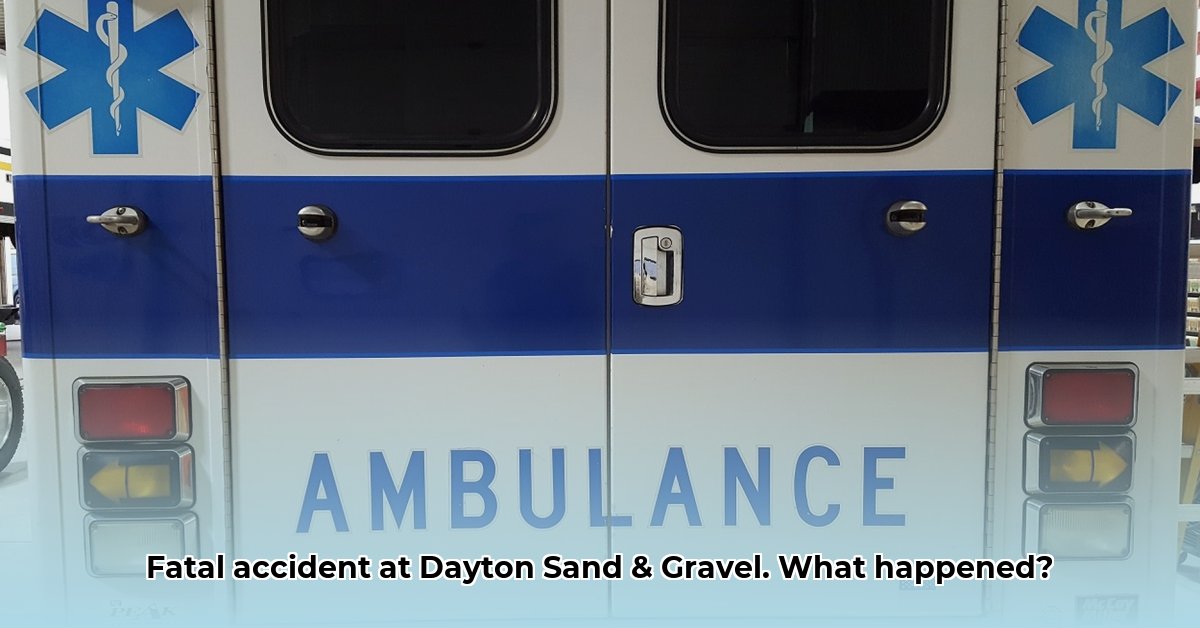
A Tragic Loss and a Call for Reform
The recent death of Cory Maddox at the Dayton Sand & Gravel facility in Dayton, Maine, has ignited a critical debate concerning workplace safety in the construction industry. Mr. Maddox, a valued employee, tragically died in an accident involving heavy machinery, highlighting significant shortcomings in current safety regulations and practices. This incident underscores the urgent need for comprehensive reform, extending beyond simple compliance to a proactive commitment to worker well-being. The accident, reported to have involved a collision with a front-end loader, occurred while Mr. Maddox was working on the site. Eyewitnesses described seeing him in the gravel yard when the incident unfolded. Initial reports raise concerns about the operator's training and the adequacy of the company's safety protocols. For more information on workplace accident statistics, see this resource.
How could this have been prevented? This incident raises many questions regarding the existing safety standards and their efficacy. The lack of detail from Dayton Sand & Gravel regarding the specifics of the accident further fuels public concern. Was the equipment operator adequately trained? Were proper safety procedures in place? These questions demand complete and transparent answers.
One key concern is the absence of mandated, recurring safety training and licensing for heavy equipment operators in Maine. Current OSHA guidelines 1 primarily focus on initial training, a practice some experts believe is insufficient to maintain consistently safe practices. Dr. Emily Carter, Professor of Occupational Safety at the University of Maine, stated, "Initial training is simply a foundation. The skills needed to safely operate heavy machinery require consistent reinforcement and regular competency checks. Without these, even the most thoroughly trained operator can become complacent and make mistakes." This continuous decay in skills represents a significant vulnerability; it's akin to relying on bicycle-riding skills learned years ago without ever practicing again.
The limited response from Dayton Sand & Gravel further complicates matters. The company's reluctance to discuss specifics hinders a complete understanding of their safety procedures. "Transparency is fundamental in these situations," comments Mr. Robert Johnson, OSHA Area Director for Southern Maine. "It's not enough to simply meet minimum requirements; proactive safety measures and open communication are critical to fostering a culture of safety." The lack of a more forthcoming response necessitates greater scrutiny from regulatory bodies.
A Critical Assessment: Identifying Systemic Gaps
The need for a comprehensive review of safety measures within the Maine construction industry is undeniable. The goal isn't to assign blame but to prevent future tragedies. This requires a multi-faceted approach involving multiple stakeholders. The following risk assessment matrix highlights key areas needing attention.
| Area of Concern | Likelihood of Failure | Impact of Failure | Risk Level | Mitigation Strategies |
|---|---|---|---|---|
| Inadequate Operator Training | High | Catastrophic, Fatalities | Critical | Mandated recurrent training, comprehensive licensing, regular competency tests, simulator-based training |
| Deficient Safety Protocols | High | Serious injuries, fatalities | Critical | Comprehensive safety manuals, routine safety audits, thorough risk assessments, prominent signage |
| Equipment Malfunctions | Medium | Serious injuries, property damage | High | Rigorous maintenance schedules, pre-shift equipment inspections, implementation of advanced safety mechanisms |
| Poor Workplace Design/Layout | Medium | Injuries, reduced efficiency | Moderate | Site redesign to minimize worker-equipment interaction, clearly defined worker pathways, improved barriers |
| Lack of Emergency Response Planning | Low | Delayed response, increased injury severity | Low | Clearly defined emergency protocols, regular drills, readily accessible emergency equipment, comprehensive staff training |
A Path Forward: Recommendations for Lasting Change
Several entities bear the responsibility for implementing significant safety improvements.
- Dayton Sand & Gravel: Must conduct an immediate, comprehensive safety review, including site improvements, updated procedures, and investment in safety technologies (e.g., proximity sensors). A fully transparent investigation and public release of its findings is crucial.
- OSHA: A complete and public investigation is essential, and findings must inform stronger regulations, mandating recurring training and professional licensing for heavy equipment operators.
- Maine Department of Labor: Should review and update existing safety regulations, collaborating with industry experts to develop robust, standardized training programs.
- The Construction Industry: Industry-wide adoption of best practices, proactive safety campaigns, and peer reviews are essential. A culture of continuous safety improvement and standardized safety certifications should be embraced.
Cory Maddox's death is a profound loss. It’s imperative that his legacy compels us to act decisively. Failure to learn from this tragedy is unacceptable. This is not simply about compliance but about prioritizing the safety and well-being of every worker. The time for meaningful and lasting change is now.